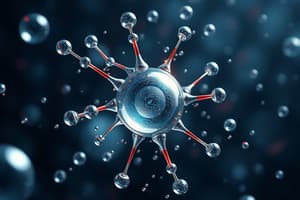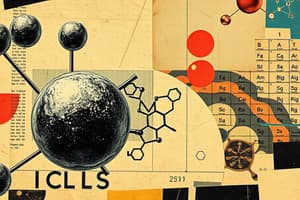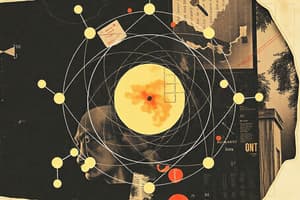Podcast
Questions and Answers
What are the products formed in the equation Water + Carbon Dioxide → Glucose + Oxygen?
What are the products formed in the equation Water + Carbon Dioxide → Glucose + Oxygen?
- Water and Glucose
- Water and Carbon Dioxide
- Glucose and Oxygen (correct)
- Oxygen and Carbon Dioxide
Which statement is true regarding reactants in a chemical reaction?
Which statement is true regarding reactants in a chemical reaction?
- Reactants are represented on the right side of the chemical equation.
- Reactants are the substances that begin a chemical reaction. (correct)
- Reactants are always gases.
- Reactants are produced at the end of a reaction.
What role does a catalyst play in a chemical reaction?
What role does a catalyst play in a chemical reaction?
- It forms new products.
- It transforms the reactants into gas.
- It speeds up the reaction. (correct)
- It slows down the reaction.
In a chemical equation, where are the reactants located?
In a chemical equation, where are the reactants located?
Which of the following is NOT a common change observed in chemical reactions?
Which of the following is NOT a common change observed in chemical reactions?
What best describes a compound?
What best describes a compound?
Which type of bond is typically associated with inorganic compounds?
Which type of bond is typically associated with inorganic compounds?
How are elements organized in the periodic table?
How are elements organized in the periodic table?
What is the role of subatomic particles in an atom?
What is the role of subatomic particles in an atom?
What is true about a chemical symbol?
What is true about a chemical symbol?
What defines a chemical reaction?
What defines a chemical reaction?
Which of these correctly describes an element?
Which of these correctly describes an element?
What type of compound is formed through a covalent bond?
What type of compound is formed through a covalent bond?
Flashcards
Atom
Atom
The smallest unit of an element that retains the chemical properties of that element.
Element
Element
A substance that cannot be broken down into simpler substances by chemical means.
Compound
Compound
A substance formed when two or more different elements combine chemically in a fixed ratio.
Covalent Bond
Covalent Bond
Signup and view all the flashcards
Ionic Bond
Ionic Bond
Signup and view all the flashcards
Proton
Proton
Signup and view all the flashcards
Neutron
Neutron
Signup and view all the flashcards
Chemical Reaction
Chemical Reaction
Signup and view all the flashcards
What is a Catalyst?
What is a Catalyst?
Signup and view all the flashcards
What are Reactants?
What are Reactants?
Signup and view all the flashcards
What are Products?
What are Products?
Signup and view all the flashcards
What is a Chemical Equation?
What is a Chemical Equation?
Signup and view all the flashcards
What are some signs a chemical reaction is happening?
What are some signs a chemical reaction is happening?
Signup and view all the flashcards
Study Notes
Atoms and Compounds
- Organisms are the most complete form of life
- Organisms are made from specialized tissues
- Tissues are made of individual cells
- Cells are made of atoms
Atoms
- Atoms and elements are on the periodic table
- Elements are organized on the periodic table by similarities and characteristics, such as electron numbers and reactions with other elements
- The periodic table can be used to determine the number of protons
Compounds
- A compound forms when two or more atoms bond chemically
- A bonded atom can become a covalent bond or an ionic bond
- Ionic bonds are inorganic compounds
- Covalent bonds are organic compounds
Elements
- An element cannot be broken down further
- The periodic table contains 118 elements, which form essential parts of human survival
- Elements are made of atoms with the same number of protons in the nucleus
Subatomic Particles
- Subatomic particles are smaller than atoms
- Protons are subatomic particles with positive charges
- Electrons are subatomic particles with negative charges
- Neutrons are subatomic particles with no charge
- Subatomic particles determine an element's atomic number and mass
Chemical Symbol
- Chemical symbols are abbreviations for elements, often from their Latin names
- If a symbol has two letters, the first is uppercase and the second is lowercase
Chemical Formula
- A chemical formula shows different elements combined
- Formulas show the ingredients needed for a compound
- An example of a chemical formula is H₂O, which is water
Chemical Reaction
- A chemical reaction transforms substances into new substances
- Chemical reactions can include noticeable changes like temperature changes or color changes
- A catalyst speeds up a chemical reaction
Reactant
- A reactant is the initial substance in a chemical reaction
- For example, in photosynthesis, water and carbon dioxide are reactants
Product
- A product is the resulting substance in a chemical reaction
- For example, in photosynthesis, glucose and oxygen are products
Chemical Equation
- A chemical equation shows a reaction using symbols and formulas instead of words
- Reactants are on the left side of the equation
- Products are on the right side of the equation
- An arrow separates reactants from products, showing the reaction direction
Studying That Suits You
Use AI to generate personalized quizzes and flashcards to suit your learning preferences.




